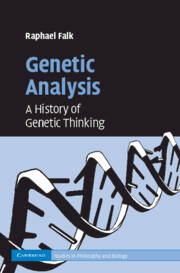Book contents
- Frontmatter
- Contents
- List of figures
- Acknowledgments
- Introduction
- PART I FROM REPRODUCTION AND GENERATION TO HEREDITY
- PART II FAKTOREN IN SEARCH OF MEANING
- PART III THE CHROMOSOME THEORY OF INHERITANCE
- PART IV GENES AS THE ATOMS OF HEREDITY
- PART V INCREASING RESOLVING POWER
- PART VI DEDUCING GENES FROM TRAITS, INDUCING TRAITS FROM GENES
- PART VII WHAT IS TRUE FOR E. COLI IS NOT TRUE FOR THE ELEPHANT
- Concluding comments
- Bibliography
- Index
PART I - FROM REPRODUCTION AND GENERATION TO HEREDITY
Published online by Cambridge University Press: 07 August 2009
- Frontmatter
- Contents
- List of figures
- Acknowledgments
- Introduction
- PART I FROM REPRODUCTION AND GENERATION TO HEREDITY
- PART II FAKTOREN IN SEARCH OF MEANING
- PART III THE CHROMOSOME THEORY OF INHERITANCE
- PART IV GENES AS THE ATOMS OF HEREDITY
- PART V INCREASING RESOLVING POWER
- PART VI DEDUCING GENES FROM TRAITS, INDUCING TRAITS FROM GENES
- PART VII WHAT IS TRUE FOR E. COLI IS NOT TRUE FOR THE ELEPHANT
- Concluding comments
- Bibliography
- Index
Summary
And Adam lived thirty and a hundred years, and begot a son in his own likeness, after his image.
Genesis 5, 3To beget a son in one's own image was considered an attribute of reproduction and generation. In biblical times, inheritance referred to the transmission of material commodities or land-ownership from one person to another:
And Abraham said, Lord God, what wilt thou give me, seeing I go childless, and the steward of my house is this Eliezer of Damascus? … And behold, the word of the Lord came unto him saying, this shall not be thine heir; but he that shall come forth out of thine own bowels shall be thine heir.
Genesis 15, 2–5Although inheritance also extended to the succession of titles and rights, it only rarely referred to the transmission of the natural traits of living creatures. Eventually, however, inheritance acquired more metaphoric connotations: “What must I do to inherit eternal life” (Mark 10, 17; Luke 10, 25 and 18, 18).
In Greek philosophy biological continuity was acknowledged as early as the fifth century BC in the Iliad, where the metaphoric inheritance of the heroic qualities of the father by the son was taken for granted. And in Euripides' Electra the continuity of traits by descendants is alluded to when a servant, finding a lock of hair, attempts to identify Orestes by its resemblance to his sister's hair.
In the Roman Empire inheritance of property was encoded in a voluminous set of laws.
- Type
- Chapter
- Information
- Genetic AnalysisA History of Genetic Thinking, pp. 11 - 13Publisher: Cambridge University PressPrint publication year: 2009



